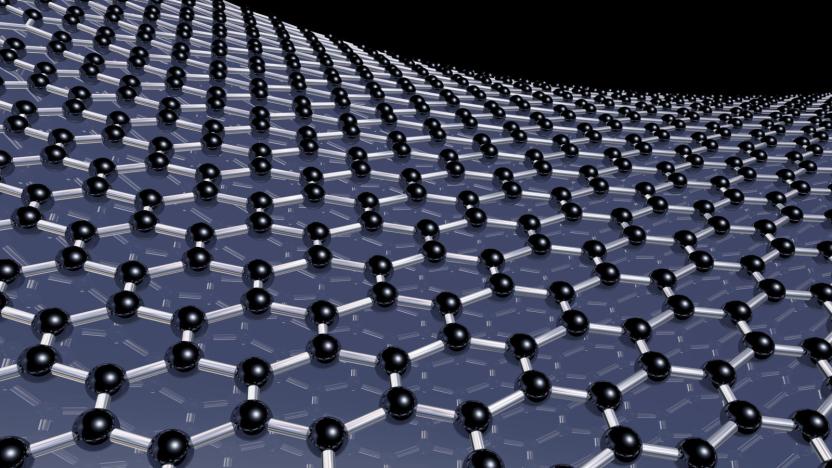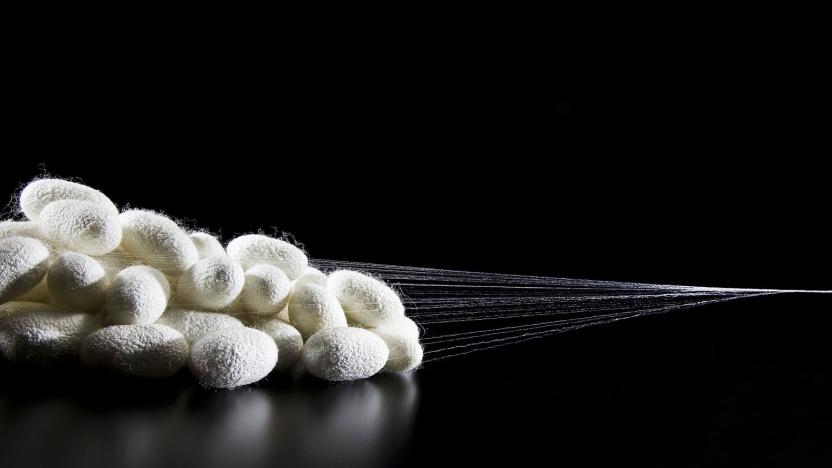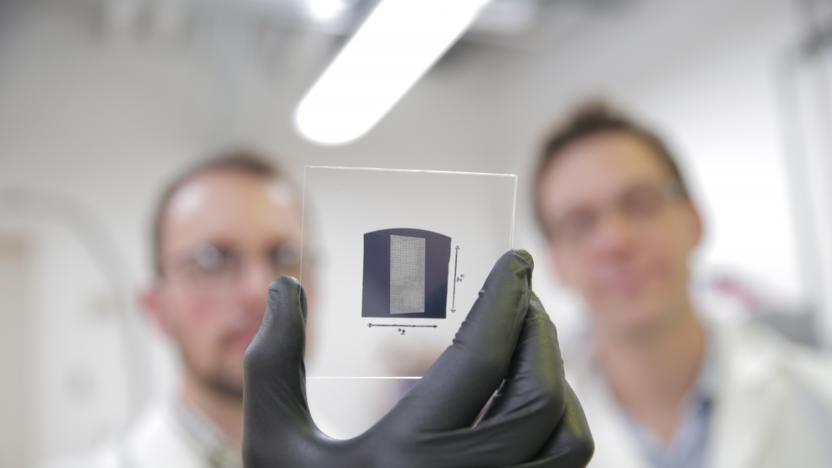carbonnanotubes
Latest

Prototype '3D' chip from MIT could eliminate memory bottlenecks
Future CPUs will have to deal with growing amounts of data, but all too often they are slowed down by bandwidth issues between the processor and RAM. A prototype chip built by researchers at Stanford and MIT can solve the problem by sandwiching the memory, processor and even sensors all into one unit. While current chips are made of silicon, the prototype processor is made of graphene carbon nanotubes, with resistive RAM (RRAM) layered over it.

Researchers make concrete production carbon neutral
Concrete is not just the key to our built future, but a principal reason as to why we won't live to see the utopia it creates. After all, production of the building material contributes around five percent of the planet's total CO2 emissions. Thankfully, Professor Stuart Licht, the scientist who's already worked out a way to save us from disaster, may have developed the solution.

Researchers design sensors that can detect single protein molecules
Carbon nanotubes promise to lead to some exciting new breakthroughs in computing, but researchers at MIT are now putting them to use in medicine and chemical engineering as well. According to a new paper published in the journal Nature Nanotechnology, MIT engineers have modified carbon nanotubes to create instruments sensitive enough to detect a single protein molecule as it is secreted by a cell.

Researchers make a graphene superconductor
Graphene is the miracle cream of the physics world, with scientists all across the globe looking to unlock its powers. Researchers at the University of Cambridge believe they've found a way to transform the substance into a superconductor. Superconductors are nothing new, of course, but they normally have to be cooled to very low temperatures to be effective. In this experiment, however, the materials were left at the current temperature. Now, like so many graphene projects, it's still early days, but if it works, it could up-end the way we build electronics forever.

Graphene-fed silkworms can spin super threads
Turns out graphene, the wonder material with so many potential applications, is also the secret sauce to making tougher silk. A team of scientists from Tsinghua University in Beijing successfully created silk that's twice as tough simply by feeding the material to silkworms. In order to do so, they coated leaves with a solution that contains either carbon nanotubes or graphene. Carbon nanotubes are essentially rolled up graphene, which is a single layer of tightly packed carbon atoms. The researchers opted for the feeding method, because it's much simpler and more environmentally friendly than treating the final product in chemicals.

Graphene key to promising treatment for spinal cord injuries
Graphene seems to have almost limitless potential, from making better batteries to night-vision windshields and microscopic sensors. And now, a team at Rice University has shown the material could be key to a promising new treatment for severe spinal cord injuries.

Carbon nanotube transistors promise faster, leaner processors
The computing industry sees carbon nanotube transistors as something of a Holy Grail. They promise not just faster performance and lower power consumption than silicon, but a way to prevent the stagnation of processor technology and the death of Moore's Law. However, their real-world speed has always lagged behind conventional technology... until now, that is. University of Wisconsin-Madison researchers have created what they say are the first carbon nanotube transistors to outpace modern silicon.

Tesla coil zaps nanotubes into a self-assembling circuit
Carbon nanotubes have gotten fanfare for rebooting Moore's Law and possibly powering the next generation of space probes, but that's not all the versatile material can do. How about shocking nanotubes with an electricity gun until they line up into neat little rows? Scientists at Rice University are firing a force field from a tesla coil at piles of carbon nanotubes until they self-assemble in a process called "Teslaphoresis". The force field oscillates positive and negative charges in each nanotube until they line up. These chains of nanotubes can form a structure and even carry a current. They light up LEDs, which are wirelessly powered by energy absorbed from the tesla coil's force field. "Normally when you talk about building circuits, you have to have physical contact. Now they're talking about building circuits without actually touching them," says Rice University scientist Carter Kattrell in a video. Pointing your lightning beam at carbon nanotubes to do your bidding is cool, but rearranging them has possibilities beyond just lighting up your Christmas tree. Depending on how they're configured, they can make a material that is stronger and lighter than kevlar or make the blackest fabric known to man. Self-assembly via electric fields isn't new, but it's only been done at extremely short ranges. The Rice scientists saw Teslaphoresis line up nanotubes from several feet away, and believe the process could chain them from the bottom-up into macro structures.

Stanford researchers make artificial skin that senses touch
A team from Stanford University might have made a breakthrough that could change the lives of people with missing limbs. Researchers have developed an artificial substitute for skin that is capable of sensing when it is being touched and sending that data to the nervous system. It's hoped that technology like this could be used to build futuristic prostheses that could be wired into the nervous systems of amputees. In addition, not only will these people be able to know if they're touching something, they'll also know how much pressure is being used.

IBM unlocks the secret to carbon nanotube transistors
Following Moore's law is getting harder and harder, especially as existing components reach their physical size limitations. Parts like silicon transistor contacts -- the "valves" within a transistor that allow electrons to flow -- simply can't be shrunken any further. However, IBM announced a major engineering achievement on Thursday that could revolutionize how computers operate: they've figured out how to swap out the silicon transistor contacts for smaller, more efficient, carbon nanotubes.

Nanotube-soaked spiders spin super-strong silk
Orb spider silk, already among the toughest and strongest materials found in nature, could soon get a super-strong nanoscale upgrade. A research team from the University of Trento, Italy recently sprayed 15 Orb-weaving spiders, members of the Pholcidae family, with carbon nanotube or graphene particle solutions. They found that doing so caused some of the spiders to spin even stronger silk than what they normally do. The team administered five spiders with a graphene-water solution and another 10 with a carbon-water mix. While some spiders subsequently spun sub-par silk (and four of them died outright), a few of the carbon-dosed arachnids actually produced strands 3.5 times stronger than the most resilient natural silk we know about.

Technology designed for aerospace could improve Parkinson's therapy
When Rice University chemist Matteo Pasquali set out to to create strong and conductive carbon nanotube fibers, he had aerospace applications in mind. But it turned out his microscopic fibers are also great at communicating with the brain, making them an ideal candidate for therapies that deal with neurological disorders such as Parkinson's disease. Pasquali said: "...once we [he and his team] had them in our hand, we realized that they had an unexpected property: They are really soft, much like a thread of silk. Their unique combination of strength, conductivity and softness makes them ideal for interfacing with the electrical function of the human body."

Scientists replicate kitty whiskers to help robots 'feel'
Cat whiskers are tremendously sensitive, so much so that cats can navigate around our glassware without sending anything crashing to the floor. It's that sort of sensitivity that a team from the University of California, Berkeley, is trying to replicate to help robots of the future. Ultra-sensitive fibers, made with carbon nanotubes and silver nanoparticles are designed to respond to pressure, helping future hardware navigate difficult and low-visibility environments. Team leader Ali Javey believes that the material is 10 times as sensitive as your smartphone display, and could even be used to track your heartbeat -- so maybe we'll be seeing this stuff getting woven together to make the next generation of connected onesies.

Stanford researchers create 'world's first' all-carbon solar cell, do it on the cheap
Harnessing the awesome power of the Sun isn't just dependent on the efficiency of solar cells, but also on making them affordable. Current techniques aren't exactly cheap, but researchers from Stanford University think they've made a bit of a breakthrough by producing a relatively inexpensive photovoltaic cell using nothing but carbon. We're sure other scientists might disagree with the 'world's first' claim, but those at Stanford think it's a matter of language, and that these other pretenders are "referring to just the active layer in the middle, not the electrodes." The team selected a trio of carbon types to use in their cell: a mixture of nanotubes and buckyballs make up the light-absorbing layer, while graphene is being utilized for the electrodes. The carbon amalgam can be applied from solution using simple methods, meaning the flexible cells could be used to coat surfaces, although you won't be seeing it smeared over anything too soon. The prototype only touts a "laboratory efficiency of less than 1 percent," so it can't compete with traditional solar cells just yet. Also, it only absorbs a sliver of the light spectrum, but the researchers are looking to other forms of the wonder element which could increase that range. They are hoping that improving the structure of the cells will help to boost their efficiency, too. They might never generate the most energy, but the all-carbon cells can remain stable under extreme conditions, meaning they could find their calling in harsh environments where brawn is a little more important than status, or looks.

IBM Labs develops 'initial step' towards commercial fabrication of carbon nanotubes
Commercialization of carbon nanotubes is one of the holy grails of next-gen computing, and IBM thinks it's made crucial steps toward making this a reality. This isn't the first time that we've heard such a claim, of course, but IBM's considerable resources will make this particularly interesting. The specific problem it's been tackling is placing enough semiconducting nanotubes together to be useful in commercial chips, with current attempts being more in the hundreds, rather than billions that would be required. The new approach uses ion-exchange chemistry that allows controlled placement of nanotubes at two orders of magnitude greater than before, with a density of roughly a billion per square centimeter. To achieve this, the nanotubes are mixed with a soap-like substance that makes them water-soluble. Next, a substrate comprising two oxides and a hafnium oxide "trench" is immersed in the soap-solution, which results in the nanotubes attaching to the hafnium oxide canals with a chemical bond. Simple when you think about it! IBM hopes that as the materials and method are readily accessible now, that industry players will be able to experiment with nanotube technology at a much greater scale. Though, as we've become accustomed, there's no solid timescales on when this might realistically unfold.

MIT pencils in carbon nanotube gas sensor that's cheaper, less hazardous (video)
Carbon nanotube-based sensors are good at sniffing out all kinds of things, but applying the cylindrical molecules to a substrate has traditionally been a dangerous and unreliable process. Now, researchers at MIT have found a way to avoid the hazardous solvents that are currently used, by compressing commercially available nanotube powders into a pencil lead-shaped material. That allowed them to sketch the material directly onto paper imprinted with gold electrodes (as shown above), then measure the current flowing through the resisting carbon nanotubes -- allowing detection of any gases that stick to the material. It works even if the marks aren't uniform, according to the team, and the tech would open up new avenues to cheaper sensors that would be particularly adroit at detecting rotten fruit or natural gas leaks. For more info, sniff out the video after the break.

Ubiquitous nanotubes could reboot Edison-era nickel-iron battery technology
Back in the 1920s, Thomas Edison's dream of an electric automobile was ultimately foiled by those meddling petroleum engines. But thanks to nanotube research from Stanford University, one legacy from that era may regain some glory: nickel-iron batteries. It turns out that carbon nanotubes doped with nickel and iron crystals can top up the normally slow-charging cells in a matter of minutes -- according to the scientists, that's almost 1,000 times faster than in the past. Although the batteries couldn't power your Volt or Prius due to a lack of energy density, they could give an extra jolt to their lithium-ion siblings for quicker starts and regenerative braking. The researchers are working on improving stability to allow more charging cycles, but it might be an extra in-your-face for Edison if it pans out.

All-carbon solar cell draws power from near-infrared light, our energy future is literally that much brighter
What's this orange-like patch, you ask? It's a layer of carbon nanotubes on silicon, and it might just be instrumental to getting a lot more power out of solar cells than we're used to. Current solar power largely ignores near-infrared light and wastes about 40 percent of the potential energy it could harness. A mix of carbon nanotubes and buckyballs developed by MIT, however, can catch that near-infrared light without degrading like earlier composites. The all-carbon formula doesn't need to be thickly spread to do its work, and it simply lets visible light through -- it could layer on top of a traditional solar cell to catch many more of the sun's rays. Most of the challenge, as we often see for solar cells, is just a matter of improving the energy conversion rate. Provided the researchers can keep refining the project, we could be looking at a big leap in solar power efficiency with very little extra footprint, something we'd very much like to see on the roof of a hybrid sedan.

Nanotubes sniff out rotting fruit, your dorm room might be next
Our favorite ultra-skinny molecules have performed a lot of useful functions over the years, but keeping fruit flies away was never one of them. Now MIT scientists, with US Army funding, have discovered a way to give these nanotubes the canine-like sense of smell needed to stop produce spoilage and waste. Doping sheets of them with copper and polystyrene introduces a speed-trap for electrons, slowing them and allowing the detection of ethylene gas vented during ripening. A sensor produced from such a substance could be combined with an RFID chip, giving grocers a cheaper way to monitor freshness and discount produce before it's too late. If that works, the team may target mold and bacteria detection next, giving you scientific proof that your roommate needs to wash his socks.

Sensitive scales can weigh individual atoms, ensure perfect recipes
Those of you who have navigated beyond using an Easy-Bake Oven will know that weighing out ingredients is a chore. Then again, it's nothing compared to the sort of balancing that takes place at the Catalan Institute of Nanotechnology, where a team has developed a method of weighing individual protons. Using heated, shortened carbon nanotubes in a vacuum, the scale vibrates at different frequencies depending on what molecules are balanced on top. The Yoctogram-scale will enable scientists to diagnose health conditions by finding differences in mass, identifying elements in chemical samples that only differ at the atomic level and ensuring you never over-flour your batter mix again.









